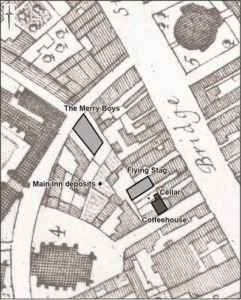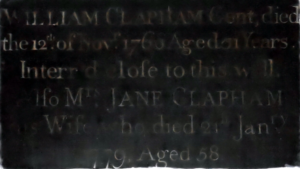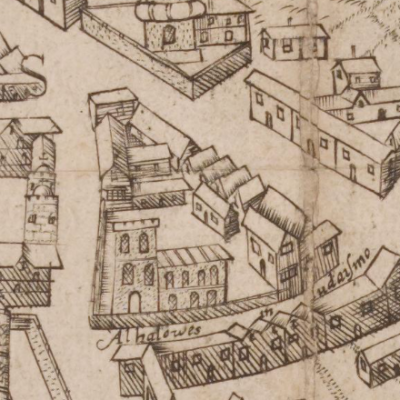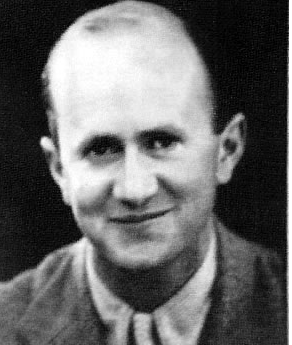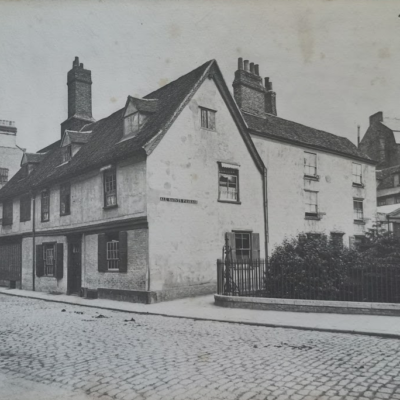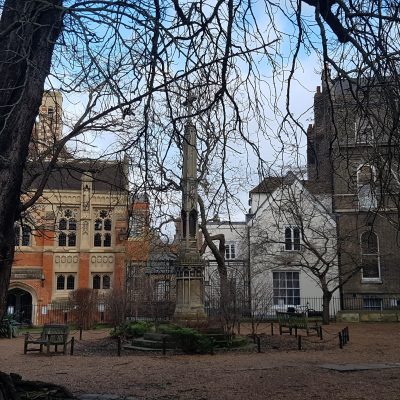Search by topic
- archaeology
- Building of Local Interest
- chapel
- charity
- church
- crime
- dressmaker
- fire
- Great Eastern Railway
- Listed building
- Mapping Relief
- medieval
- oral history
- poverty
- Public House
- Religious House
- Roman
- scholar
- school
- Then and Now
- tudor
- women
- work
- world war one
- world war two
Search by text
Clapham’s Coffee House, All Saint’s Passage
History of Clapham's Coffee House
The map shows the approximate site of the coffee house whose remains were excavated 2005-12. A detailed account of the excavation can be found here:
https://www.tandfonline.com/doi/full/10.1080/00794236.2017.1363146
It was carried out by the Cambridge Archaeological unit on behalf of St John’s College and involved an unprecedented amount of remains from an 18th century coffee house. It was one of nine coffee houses known to exist in Cambridge in the year 1760. From 1753 the Licensing Act required the licences of coffee houses that served alcohol, although there were some that did not. All the information that follows has been selected from the report mentioned above:
Whilst a coffeehouse may have been located in the vicinity of Clapham’s since c. 1718, the documentary evidence for this is at best circumstantial. Neither William Clapham nor his wife Jane Heron appear to have had any familial connections with Cambridgeshire and both are described as being of Romford, Essex, when they married in late 1746 in London. By 1748 — and possibly as early as 1746, as the records for 1746–47 do not survive — William Clapham obtained a victualling licence in Cambridge for his coffeehouse. In 1751, the coffeehouse is mentioned in a poem called ‘The Lownger’ in The Student or Oxford and Cambridge Monthly Miscellany II, where a footnote describes it and another establishment as ‘Noted coffee-houses in Cambridge’:
I rise about nine, get to breakfast by ten,
Blow a tune on my Flute, or perhaps make a Bow;
Read a play till eleven, or cock my lac’d hat,
Then step to my Neighb’rs till Dinner to chat.
Dinner over, to Tom’s or to Clapham’s I go
The news of the town so impatient to know
…
From the Coffee-house then I to Tennis away.
William renewed his victualling licence annually until 1762, when he ‘left & was succeeded by Mary and Elizabeth Sproson’. The Claphams appear never to have had children, and William Clapham of Chesterton near Cambridge was buried at Chesterton in 1765, leaving the bulk of his estate, provisionally valued at well over £1000, to his wife Jane. In 1769 the property was described as ‘then or lately used for several years’ as a coffeehouse, with an untenanted cellar, occupied by Mrs Jane Clapham or her under-tenants. Before she died in 1779 Jane Clapham was living in Clerkenwell, London, and her closest living relative was her brother John Heron, who was living in Holborn. Jane wished to be interred beside William and was buried in Chesterton. There is no evidence from Jane’s will to suggest that she was still involved in running the coffeehouse by 1779; the majority of the named beneficiaries had no connection to Cambridgeshire, although there were minor bequests to two local women.
There is some confusion over the precise names and dates associated with this tablet in St Andrew’s Chesterton. It appears to have been erected after the death of James.
‘WILLIAM CLAPHAM Gent, died / the 12th of Novr 1766, Aged 61 years. / Interr’d close to this wall. / Also Mrs JANE CLAPHAM / his Wife who died 21st Janry / 1779, Aged 68’.
The earliest evidence for Mary Sproson in Cambridge dates from 1757, when she obtained a victualling licence for a coffeehouse in Great St Mary’s parish; her sister Elizabeth became co-licensee in 1759. This coffeehouse appears to have closed when they took over as licensees to Clapham’s in 1762. Elizabeth apparently left the business in 1763, while Mary remained the licensee of Clapham’s until 1774. As no licence was issued from 1775 onwards, the coffeehouse must have ceased to sell alcohol. Both sisters continued to live in Cambridge, with Elizabeth marrying in 1779 and dying in 1815, whilst Mary died in 1808.
By 1782 the property was called the Union Coffee House, and was run by Francis/Frank Smith. The clientele of Union Coffee House is described in a set of Tripos verses in 1788, and, whilst this depiction is unlikely to be entirely representative, it provides an impression of the range of individuals who may have frequented Clapham’s a few years earlier … The Union Coffee House has been described as a ‘general rendezvous of all the young nobility and fellow commoners’; these were the wealthier students who were prepared to pay extra for certain privileges and typically had little interest in academic activities. The Union Coffee House closed c. 1815 and the associated buildings were demolished at approximately the same date.
The notes, tables and further information associated with this extract should be be viewed by following the hyperlink above. There is much detailed information about the archaeological finds themselves.
Contribute
Do you have any information about the people or places in this article? If so, then please let us know using the Contact page or by emailing capturingcambridge@
License
This work is licensed under CC BY-NC-SA 4.0





